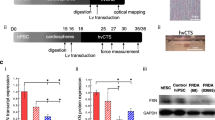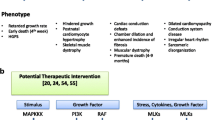Abstract
Friedreich ataxia (FRDA), a recessive neurodegenerative disorder commonly associated with hypertrophic cardiomyopathy, is due to GAA repeat expansions within the first intron of the frataxin (FXN) gene encoding the mitochondrial protein involved in iron–sulfur cluster biosynthesis. The triplet codon repeats lead to heterochromatin-mediated gene silencing and loss of frataxin. Nevertheless, inadequacy of existing FRDA-cardiac cellular models limited cardiomyopathy studies. We tested the hypothesis that iron homeostasis deregulation accelerates reduction in energy synthesis dynamics which contributes to impaired cardiac calcium homeostasis and contractile force. Silencing of FXN expressions occurred both in somatic FRDA-skin fibroblasts and two of the induced pluripotent stem cells (iPSC) clones; a sign of stress condition was shown in FRDA-iPSC cardiomyocytes with disorganized mitochondrial network and mitochondrial DNA (mtDNA) depletion; hypertrophic cardiac stress responses were observed by an increase in α-actinin-positive cell sizes revealed by FACS analysis as well as elevation in brain natriuretic peptide (BNP) gene expression; the intracellular iron accumulated in FRDA cardiomyocytes might be due to attenuated negative feedback response of transferring receptor (TSFR) expression and positive feedback response of ferritin (FTH1); energy synthesis dynamics, in terms of ATP production rate, was impaired in FRDA-iPSC cardiomyocytes, which were prone to iron overload condition. Energetic insufficiency determined slower Ca2+ transients by retarding calcium reuptake to sarcoplasmic reticulum (SR) and impaired the positive inotropic and chronotropic responses to adrenergic stimulation. Our data showed for the first time that FRDA-iPSCs cardiac derivatives represent promising models to study cardiac stress response due to impaired iron homeostasis condition and mitochondrial damages. The cardiomyopathy phenotype was accelerated in an iron-overloaded condition early in calcium homeostasis aspect.







Similar content being viewed by others
References
Bayot A, Santos R, Camadro JM, Rustin P (2011) Friedreich's ataxia: the vicious circle hypothesis revisited. BMC Med 9:112. doi:10.1186/1741-7015-9-112
Bradley JL, Blake JC, Chamberlain S, Thomas PK, Cooper JM, Schapira AH (2000) Clinical, biochemical and molecular genetic correlations in Friedreich's ataxia. Hum Mol Genet 9:275–82
Bradley JL, Blake JC, Chamberlain S, Thomas PK, Cooper JM, Schapira AH (2000) Clinical, biochemical and molecular genetic correlations in Friedreich's ataxia. Human molecular genetics 9:275–82
Bunse M, Bit-Avragim N, Riefflin A, Perrot A, Schmidt O, Kreuz FR, Dietz R, Jung WI, Osterziel KJ (2003) Cardiac energetics correlates to myocardial hypertrophy in Friedreich's ataxia. Ann Neurol 53:121–3. doi:10.1002/ana.10419
Campuzano V, Montermini L, Molto MD, Pianese L, Cossee M, Cavalcanti F, Monros E, Rodius F, Duclos F, Monticelli A, Zara F, Canizares J, Koutnikova H, Bidichandani SI, Gellera C, Brice A, Trouillas P, De Michele G, Filla A, De Frutos R, Palau F, Patel PI, Di Donato S, Mandel JL, Cocozza S, Koenig M, Pandolfo M (1996) Friedreich's ataxia: autosomal recessive disease caused by an intronic GAA triplet repeat expansion. Science 271:1423–7
Chantrel-Groussard K, Geromel V, Puccio H, Koenig M, Munnich A, Rotig A, Rustin P (2001) Disabled early recruitment of antioxidant defenses in Friedreich's ataxia. Hum Mol Genet 10:2061–7
Fujikawa M, Yoshida M (2010) A sensitive, simple assay of mitochondrial ATP synthesis of cultured mammalian cells suitable for high-throughput analysis. Biochem Biophys Res Commun 401:538–43. doi:10.1016/j.bbrc.2010.09.089
Geoffroy G, Barbeau A, Breton G, Lemieux B, Aube M, Leger C, Bouchard JP (1976) Clinical description and roentgenologic evaluation of patients with Friedreich's ataxia. Can J Neurol Sci 3:279–86
Herman D, Jenssen K, Burnett R, Soragni E, Perlman SL, Gottesfeld JM (2006) Histone deacetylase inhibitors reverse gene silencing in Friedreich's ataxia. Nat Chem Biol 2:551–8. doi:10.1038/nchembio815
Hick A, Wattenhofer-Donze M, Chintawar S, Tropel P, Simard JP, Vaucamps N, Gall D, Lambot L, Andre C, Reutenauer L, Rai M, Teletin M, Messaddeq N, Schiffmann SN, Viville S, Pearson CE, Pandolfo M, Puccio HM (2013) Induced pluripotent stem cell derived neurons and cardiomyocytes as a model for mitochondrial defects in Friedreich's ataxia. Dis Model Mech 6(3):608–612. doi:10.1242/dmm.010900
Horowitz MP, Greenamyre JT (2010) Mitochondrial iron metabolism and its role in neurodegeneration. J Alzheimers Dis 20(Suppl 2):S551–68
Huang ML, Becker EM, Whitnall M, Suryo Rahmanto Y, Ponka P, Richardson DR (2009) Elucidation of the mechanism of mitochondrial iron loading in Friedreich's ataxia by analysis of a mouse mutant. Proc Natl Acad Sci U S A 106:16381–6. doi:10.1073/pnas.0906784106
Kipps A, Alexander M, Colan SD, Gauvreau K, Smoot L, Crawford L, Darras BT, Blume ED (2009) The longitudinal course of cardiomyopathy in Friedreich's ataxia during childhood. Pediatr Cardiol 30:306–10. doi:10.1007/s00246-008-9305-1
Ku S, Soragni E, Campau E, Thomas EA, Altun G, Laurent LC, Loring JF, Napierala M, Gottesfeld JM (2010) Friedreich's ataxia induced pluripotent stem cells model intergenerational GAATTC triplet repeat instability. Cell Stem Cell 7:631–7. doi:10.1016/j.stem.2010.09.014
Lai WH, Ho JC, Lee YK, Ng KM, Au KW, Chan YC, Lau CP, Tse HF, Siu CW (2010) ROCK inhibition facilitates the generation of human-induced pluripotent stem cells in a defined, feeder-, and serum-free system. Cell Reprogram 12:641–53. doi:10.1089/cell.2010.0051
Lamarche JB, Cote M, Lemieux B (1980) The cardiomyopathy of Friedreich's ataxia morphological observations in 3 cases. Can J Neurol Sci 7:389–96
Lee YK, Ng KM, Lai WH, Chan YC, Lau YM, Lian Q, Tse HF, Siu CW (2011) Calcium homeostasis in human induced pluripotent stem cell-derived cardiomyocytes. Stem Cell Rev 7:976–86. doi:10.1007/s12015-011-9273-3
Lian Q, Zhang Y, Zhang J, Zhang HK, Wu X, Lam FF, Kang S, Xia JC, Lai WH, Au KW, Chow YY, Siu CW, Lee CN, Tse HF (2010) Functional mesenchymal stem cells derived from human induced pluripotent stem cells attenuate limb ischemia in mice. Circulation 121:1113–23. doi:10.1161/CIRCULATIONAHA.109.898312
Liu J, Verma PJ, Evans-Galea MV, Delatycki MB, Michalska A, Leung J, Crombie D, Sarsero JP, Williamson R, Dottori M, Pebay A (2011) Generation of induced pluripotent stem cell lines from Friedreich ataxia patients. Stem Cell Rev 7:703–13. doi:10.1007/s12015-010-9210-x
Martelli A, Wattenhofer-Donze M, Schmucker S, Bouvet S, Reutenauer L, Puccio H (2007) Frataxin is essential for extramitochondrial Fe-S cluster proteins in mammalian tissues. Human molecular genetics 16:2651–8. doi:10.1093/hmg/ddm163
Michael S, Petrocine SV, Qian J, Lamarche JB, Knutson MD, Garrick MD, Koeppen AH (2006) Iron and iron-responsive proteins in the cardiomyopathy of Friedreich's ataxia. Cerebellum 5:257–67. doi:10.1080/14734220600913246
Payne RM (2011) The heart in Friedreich's ataxia: basic findings and clinical implications. Prog Pediatr Cardiol 31:103–109. doi:10.1016/j.ppedcard.2011.02.007
Payne RM, Wagner GR (2012) Cardiomyopathy in Friedreich ataxia: clinical findings and research. J Child Neurol 27:1179–86. doi:10.1177/0883073812448535
Puccio H, Simon D, Cossee M, Criqui-Filipe P, Tiziano F, Melki J, Hindelang C, Matyas R, Rustin P, Koenig M (2001) Mouse models for Friedreich ataxia exhibit cardiomyopathy, sensory nerve defect and Fe–S enzyme deficiency followed by intramitochondrial iron deposits. Nature genetics 27:181–6. doi:10.1038/84818
Ramirez RL, Qian J, Santambrogio P, Levi S, Koeppen AH (2012) Relation of cytosolic iron excess to cardiomyopathy of Friedreich's ataxia. Am J Cardiol 110:1820–7. doi:10.1016/j.amjcard.2012.08.018
Rindler PM, Clark RM, Pollard LM, De Biase I, Bidichandani SI (2006) Replication in mammalian cells recapitulates the locus-specific differences in somatic instability of genomic GAA triplet-repeats. Nucleic Acids Res 34:6352–61. doi:10.1093/nar/gkl846
Rotig A, de Lonlay P, Chretien D, Foury F, Koenig M, Sidi D, Munnich A, Rustin P (1997) Aconitase and mitochondrial iron–sulphur protein deficiency in Friedreich ataxia. Nature genetics 17:215–7. doi:10.1038/ng1097-215
Schulz JB, Boesch S, Burk K, Durr A, Giunti P, Mariotti C, Pousset F, Schols L, Vankan P, Pandolfo M (2009) Diagnosis and treatment of Friedreich ataxia: a European perspective. Nat Rev Neurol 5:222–34
Sturm B, Bistrich U, Schranzhofer M, Sarsero JP, Rauen U, Scheiber-Mojdehkar B, de Groot H, Ioannou P, Petrat F (2005) Friedreich's ataxia, no changes in mitochondrial labile iron in human lymphoblasts and fibroblasts: a decrease in antioxidative capacity? J Biol Chem 280:6701–8. doi:10.1074/jbc.M408717200
Sun N, Yazawa M, Liu J, Han L, Sanchez-Freire V, Abilez OJ, Navarrete EG, Hu S, Wang L, Lee A, Pavlovic A, Lin S, Chen R, Hajjar RJ, Snyder MP, Dolmetsch RE, Butte MJ, Ashley EA, Longaker MT, Robbins RC, Wu JC (2012) Patient-specific induced pluripotent stem cells as a model for familial dilated cardiomyopathy. Sci Transl Med 4:130ra47 DOI 4/130/130ra47 [pii] 10.1126/scitranslmed.3003552
Takahashi K, Tanabe K, Ohnuki M, Narita M, Ichisaka T, Tomoda K, Yamanaka S (2007) Induction of pluripotent stem cells from adult human fibroblasts by defined factors. Cell 131:861–72. doi:10.1016/j.cell.2007.11.019
Wallander ML, Leibold EA, Eisenstein RS (2006) Molecular control of vertebrate iron homeostasis by iron regulatory proteins. Biochim Biophys Acta 1763:668–89. doi:10.1016/j.bbamcr.2006.05.004
Whitnall M, Suryo Rahmanto Y, Sutak R, Xu X, Becker EM, Mikhael MR, Ponka P, Richardson DR (2008) The MCK mouse heart model of Friedreich's ataxia: alterations in iron-regulated proteins and cardiac hypertrophy are limited by iron chelation. Proc Natl Acad Sci U S A 105:9757–62. doi:10.1073/pnas.0804261105
Yu J, Vodyanik MA, Smuga-Otto K, Antosiewicz-Bourget J, Frane JL, Tian S, Nie J, Jonsdottir GA, Ruotti V, Stewart R, Slukvin II, Thomson JA (2007) Induced pluripotent stem cell lines derived from human somatic cells. Science 318:1917–20. doi:10.1126/science.1151526
Zhang J, Lian Q, Zhu G, Zhou F, Sui L, Tan C, Mutalif RA, Navasankari R, Zhang Y, Tse HF, Stewart CL, Colman A (2011) A human iPSC model of Hutchinson Gilford Progeria reveals vascular smooth muscle and mesenchymal stem cell defects. Cell Stem Cell 8:31–45. doi:10.1016/j.stem.2010.12.002
Zuhlke CH, Dalski A, Habeck M, Straube K, Hedrich K, Hoeltzenbein M, Konstanzer A, Hellenbroich Y, Schwinger E (2004) Extension of the mutation spectrum in Friedreich's ataxia: detection of an exon deletion and novel missense mutations. Eur J Hum Genet 12:979–82. doi:10.1038/sj.ejhg.52012575201257
Acknowledgments
This work was supported by grants from the Hong Kong Research Grant Council (HKU 776912 M to Drs. Siu and Lau) and Israel Science Foundation, The Ministry of Health—Chief Scientist, the Rappaport Family Institute for Research in the Medical Sciences, and The Sohnis and Forman Families Stem Cells Center (to Ofer Binah).
Conflict of Interest
The authors have nothing to disclose.
Author information
Authors and Affiliations
Corresponding author
Additional information
Yee-Ki Lee and Philip Wing-Lok Ho contributed equally to this work.
Rights and permissions
About this article
Cite this article
Lee, YK., Ho, P.WL., Schick, R. et al. Modeling of Friedreich ataxia-related iron overloading cardiomyopathy using patient-specific-induced pluripotent stem cells. Pflugers Arch - Eur J Physiol 466, 1831–1844 (2014). https://doi.org/10.1007/s00424-013-1414-x
Received:
Revised:
Accepted:
Published:
Issue Date:
DOI: https://doi.org/10.1007/s00424-013-1414-x




